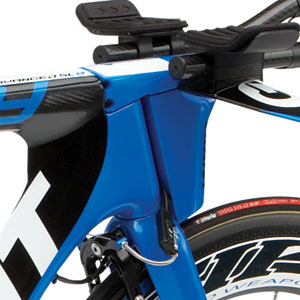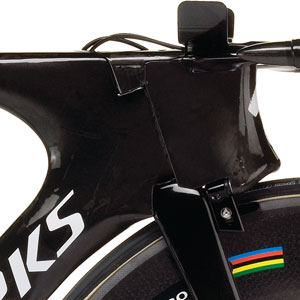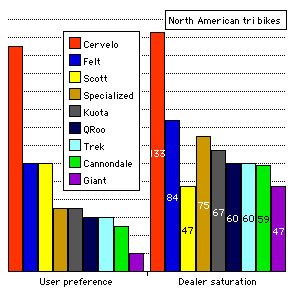2010 Tri bikes

In point of fact, and notwithstanding the pleas and protests of your calendar, 2010 is here. This, because industry has deemed the calendar year outmoded for its purposes. Rather, the weather is what matters. Bikes are bought in the late Winter and Spring. They have to be in showrooms in January, or the month before, or two months before.
Further to the point, bikes are now overwhelmingly made in China, concentrated into a few factories. Those factories require lead times, and brands are jockeying for factory space. American companies like Trek, Specialized and Cannondale are American in name, industrial design, engineering, but the majority of American bikes—even expensive, pro bikes—are actually made in the Orient (though Trek still does make a lot of its bikes stateside).
Because manufacturers' orders to these Oriental factories must be placed early to guarantee their completion on time for the commencement of the season, factory reps have already been in to see your local LBS, have shown buyers the 2010 line, and have extracted from them their best guesses as to what you will buy "next" year. No longer do we find out at Eurobike or Interbike (the industry's bike trade shows) what all the subsequent year's products will look like. In many cases we already know. We have the pictures. And the prices. And the spec. So why linger? Let's show you the 2010 model year of bikes starting now.
Do these bikes share common themes?
UCI legality, for one. At least at the upper end. Why? Because triathlon is the beneficiary of the new business and tactical paradigms in pro bike racing: the accelerated importance of the timed race bike; and the Pro Tour team shift away from European bike brands. For this reason, Scott, Specialized, Trek, Cannondale, Felt and Giant all spend an inordinate amount of money and energy building bikes that the triathlon market cannot monetarily support. No problem. These bikes weren't built for triathletes. But triathletes get them anyway.
How nice! Just know that there's not a UCI-illegal bike among them, so, whatever technical advantages you get from these inflated engineering budgets are tempered by the constraints the UCI places on the bikes.
For example, you'll note that they all have level top tubes. Not because level top tubes are faster. Rather, because the UCI requires it. The trick is to make a bike perform, aerodynamically, as well as the old Lotus and GT bikes made 15 or more years ago (generally today's bikes "compete" with these old bikes very well, but it's taken some doing).
You'll also notice that this new generation of bikes features stems that for practical purposes… aren't stems, per se. The aerobar affixes to a fork shaped as the leading edge of a construct in which the head tube is the trailing edge. A clamp system on top of the fork envelopes or accepts the pursuit bar. All this occurs below the head tube top, so that the top of this entire fork/frame/stem construct is seamless and even in elevation. (The adjacent pics of the blue Giant Trinity Advanced, and the black Specialized Shiv, illustrate this).

For fitting purposes, the frame's stack and reach needs to be measured at or near the headset top bearing. This is the traditional place where the head tube top occurs. Strictly speaking, the forks in these bikes have not been lowered, rather the top tube elevation has been raised.
Many of these bikes now have taken a route that requires integration of the aerobar into the frame. One can clearly see this from the design of Giant's Trinity Advanced series of bikes. Once locked into this paradigm, the brand takes upon itself the onus of aerobar maker. The aerobar's fit, comfort, ergonomics, handling, adjustability, modularity are all on the back of the bike maker now, and this is important to note. Why? Because the frame is not a contact point. Aerobars and saddles are contact points. While a frame tends to disappear under the rider once boarded, the saddle, the armrests, the extensions and pursuit position do not disappear, especially if they are uncomfortable.
These are not necessarily bad trends, rather that companies that want to be bike makers, not frame makers, accept this challenge. It's up to you, the rider, to determine whether the bike is comfortable. This places a burden on the bike maker, to make sure the entire bike functions: for want of the armrest the bike is lost. Circle back, dear reader, to the point further above: These new bikes are sexy, but they weren't built for you. They were built for pro cycling teams, the riders of which spend less time on their timed race bikes than you do, both in training and in racing.
Here's a question for you to ponder: If these bikes were made for a bike brand's pro teams, not for triathletes, do these companies really care whether they sell these bikes to triathletes or not? It depends on the company. In the case of Cervelo and Felt, yes, it matters to them a great deal. They are the leaders in unit sales to multisporters, and they do not have offsetting revenues from other categories that make the timed race category a revenue throw-away. Accordingly, their bikes must be made not only for their pro cyclists, but for triathletes.
What about Trek, Cannondale, Giant, Specialized, Scott? I think at the very top—at the $10,000 and up price category—these bikes are made for pro cyclists. In most cases, however, models with these same top-end technologies and features are made down to half that cost and, when this happens, these brands are clearly trying to sell to you all. A Giant Trinity Advanced can be bought for $5000, and a Cannondale Slice for $2800. Why make the effort if these brands do not want your business?
What does this mean to you? It means there are some fantastic technologies made available to you for 2010, really the first time all the major companies have come out, or will come out, with a new generation of timed race bikes built for 30 mph but sold to those who'll ride them at 20 mph. Your job is to determine whether you can ride comfortably aboard these bikes. Maybe you can. But you need to do your homework—you need to, at a minimum, have your new prospective muscle bike placed on a trainer at your LBS, fit to your coordinates, and you must ride this bike and see if it really is comfortable.
Think about all the reasons these exciting new 2010 bikes are made as they are. Try to determine which of these reasons are applicable to you. For example, you'll note that a lot of these pro cyclists rode their bikes during 2009 with very tall armrest pedestals. One explanation I heard for this is that these pedestals were the one element not regulated by the UCI last year. So, riders debased in size their UCI-rule-encumbered bikes far underneath them so that they could maximize armrest pedestals not subject to a 3:1 aspect ratio. Do you want to buy a bike ridden in this sort of configuration, and for this reason?
Do your homework, test ride your new bike, fit to you, at least on a trainer if not on the road. Only then should you buy.
Now to some final paperwork. We've got a new format for describing all these bikes. We used to write about them several bikes at a time, as in, three or four tri bikes all made within a particular price point, all in one article. Now they'll be written about a single bike a time—one bike per article. This, because it makes site navigation easier: We can database each of these articles by price, by type, by brand, however we want. This ought to make it easier for you to find the information you're looking for here on Slowtwitch.
Between now and the rest of this year, we'll be overviewing all the 2010 tri bikes relevant to you.



Start the discussion at slowtwitch.northend.network